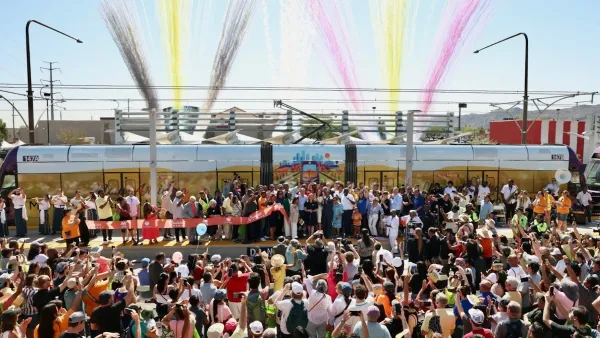On August 25, voters in Phoenix and Maricopa County will determine the outcome of Proposition 104, a transportation sales tax measure that would raise $17 billion for a wide variety of transportation improvements, including extended light rail.
Reporting from store's adjacent to Phoenix's light rail line, Nick VinZant interviews business owners and passersby on how they will vote on Proposition 104 which "calls for more than $240 million in road and bridge repair, 135 miles of new sidewalks, 1,000 miles of new bike lanes, expanded bus service and 40 miles of new light rail lines."
Maricopa County "is currently the second fastest growing county in the United States," according to AARP. More from that group below. Phoenix, the county seat, is the sixth largest city in the United States, and among the fastest growing.
According to Move PHX, the group behind the measure, "the tax will continue the existing four-tenths of a penny tax and increase it by three-tenths of a cent, resetting the total rate to seven-tenths of a cent." In a guide to all the measures on the August 25 ballot, The Arizona Republic notes that the measure will last for 35 years.
As noted here last month, Democrat Mayor Greg Stanton, elected in 2011, is a staunch proponent of the measure, seeing it as key to tripling light rail mileage. Valley Metro Rail is currently 22 miles, with a 3.1 mile extension planned to open in Mesa, Maricopa County, 20 miles west of Phoenix on August 22.
For a complete list of projects the measure will fund, see MovePHX breakdown for five categories of spending:
- Cars
- Pedestrians
- Bikes
- Light Rail
- Buses
Eric Jay Toll of Phoenix Business Journal reports on an Arizona Talks forum in downtown Phoenix on July 27 where Phoenix City Councilmember Kate Gallego, co-chair of the MovePHX advocacy committee, and Randall O'Toole, Oregon-based senior analyst for the Cato Institute think tank, debated Proposition 104. "O’Toole was a spokesman for opponents of the original light rail proposition in 2000."
Last paragraph goes to the AARP (formerly the American Association of Retired Persons) explaining why pedestrian infrastructure and safety measures were key to their endorsement Proposition 104.
"Crossing the street shouldn’t mean crossing your fingers,” said Dana Marie Kennedy, AARP Arizona State Director. “Yet every two hours, a pedestrian in the United States is killed because a street or crosswalk is unsafe. Children, seniors, people of color and the low-income are disproportionately the victims of these fatalities. That’s why AARP is supporting Proposition 104, which will be on the Phoenix City Election Ballot in August."
FULL STORY: Proposition 104 billed as future of transportation in Valley

Planetizen Federal Action Tracker
A weekly monitor of how Trump’s orders and actions are impacting planners and planning in America.

Map: Where Senate Republicans Want to Sell Your Public Lands
For public land advocates, the Senate Republicans’ proposal to sell millions of acres of public land in the West is “the biggest fight of their careers.”

Restaurant Patios Were a Pandemic Win — Why Were They so Hard to Keep?
Social distancing requirements and changes in travel patterns prompted cities to pilot new uses for street and sidewalk space. Then it got complicated.

Albuquerque Route 66 Motels Become Affordable Housing
A $4 million city fund is incentivizing developers to breathe new life into derelict midcentury motels.

DC Area County Eliminates Bus Fares
Montgomery County joins a growing trend of making transit free.

Platform Pilsner: Vancouver Transit Agency Releases... a Beer?
TransLink will receive a portion of every sale of the four-pack.
Urban Design for Planners 1: Software Tools
This six-course series explores essential urban design concepts using open source software and equips planners with the tools they need to participate fully in the urban design process.
Planning for Universal Design
Learn the tools for implementing Universal Design in planning regulations.
Heyer Gruel & Associates PA
JM Goldson LLC
Custer County Colorado
City of Camden Redevelopment Agency
City of Astoria
Transportation Research & Education Center (TREC) at Portland State University
Camden Redevelopment Agency
City of Claremont
Municipality of Princeton (NJ)



























